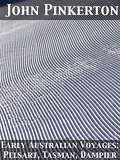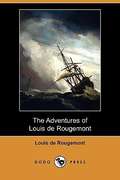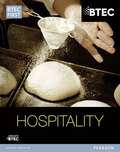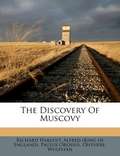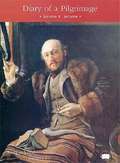- Table View
- List View
Early Australian Voyages: Pelsart, Tasman, Dampier
by John PinkertonThe Essential Library presents John Pinkerton's "Early Australian Voyages," a captivating account of true-life stories of courage and daring. Meet the brave explorers who were the first to cross the uncharted seas.
Police Car (UEB Contracted)
by Rnib BookshareThe police car is seen from the side, with only two of its four wheels showing at the bottom of the page. There is a locator dot shown, which will be at the top left of the page when the image is the right way up. The front (bonnet) of the car is at the left, and the rear (boot) at the right. The bumpers stick out slightly at the lower front and rear of the car. Above the front bumper is one headlight. Just to the right and slightly below this, the emergency vehicle reflective strip runs the length of the car, with one of the tail lights just above and to the right of it at the top of the boot. In the centre of the image, to the left is one front door and one rear door to the right. Each has a door handle just above the reflective strip, with a window above that. The wing mirror is shown at the lower left of the front window. At the top of the image, the blue emergency light is in the middle of the car's roof, with a tall aerial to its right.
Police Car (UEB uncontracted)
by Rnib BookshareThe police car is seen from the side, with only two of its four wheels showing at the bottom of the page. There is a locator dot shown, which will be at the top left of the page when the image is the right way up. The front (bonnet) of the car is at the left, and the rear (boot) at the right. The bumpers stick out slightly at the lower front and rear of the car. Above the front bumper is one headlight. Just to the right and slightly below this, the emergency vehicle reflective strip runs the length of the car, with one of the tail lights just above and to the right of it at the top of the boot. In the centre of the image, to the left is one front door and one rear door to the right. Each has a door handle just above the reflective strip, with a window above that. The wing mirror is shown at the lower left of the front window. At the top of the image, the blue emergency light is in the middle of the car's roof, with a tall aerial to its right.
Mountain Rescue Land Rover (Large Print)
by Rnib BookshareThe Land Rover is viewed from the side with only two of its four wheels showing at the bottom of the page. There is a locator dot shown, which will be at the top left of the page when the image is the right way up.The front of the Land Rover is on the left of the page and the rear on the right. There is a winch sticking out just above and to the left of the front wheel. Up and right from this is an extra headlight. The emergency vehicle reflective strip runs the entire length of the vehicle from here. In the centre of the image are two of the Land Rover's doors. The front door to the left has a mirror in the bottom left corner of its window. The door handles are near the bottom right corner of each window. Up from the front door is a large spotlight on the front corner of the roof, and to the right of this is the blue emergency light on a small raised block. To the right of this is the aerial and then a large roof rack for equipment. On the far right of the vehicle is the rear light.
Mountain Rescue Land Rover (UEB Contracted)
by Rnib BookshareThe Land Rover is viewed from the side with only two of its four wheels showing at the bottom of the page. There is a locator dot shown, which will be at the top left of the page when the image is the right way up.The front of the Land Rover is on the left of the page and the rear on the right. There is a winch sticking out just above and to the left of the front wheel. Up and right from this is an extra headlight. The emergency vehicle reflective strip runs the entire length of the vehicle from here. In the centre of the image are two of the Land Rover's doors. The front door to the left has a mirror in the bottom left corner of its window. The door handles are near the bottom right corner of each window. Up from the front door is a large spotlight on the front corner of the roof, and to the right of this is the blue emergency light on a small raised block. To the right of this is the aerial and then a large roof rack for equipment. On the far right of the vehicle is the rear light.
Mountain Rescue Land Rover (UEB uncontracted)
by Rnib BookshareThe Land Rover is viewed from the side with only two of its four wheels showing at the bottom of the page. There is a locator dot shown, which will be at the top left of the page when the image is the right way up.The front of the Land Rover is on the left of the page and the rear on the right. There is a winch sticking out just above and to the left of the front wheel. Up and right from this is an extra headlight. The emergency vehicle reflective strip runs the entire length of the vehicle from here. In the centre of the image are two of the Land Rover's doors. The front door to the left has a mirror in the bottom left corner of its window. The door handles are near the bottom right corner of each window. Up from the front door is a large spotlight on the front corner of the roof, and to the right of this is the blue emergency light on a small raised block. To the right of this is the aerial and then a large roof rack for equipment. On the far right of the vehicle is the rear light.
American Notes
by Rudyard KiplingThis is what Bret Harte has written of the great city of San Francisco, and for the past fortnight I have been wondering what made him do it. There is neither serenity nor indifference to be found in these parts; and evil would it be for the continents whose wardship were intrusted to so reckless a guardian. Behold me pitched neck-and-crop from twenty days of the high seas into the whirl of California, deprived of any guidance, and left to draw my own conclusions. <P> <P> Protect me from the wrath of an outraged community if these letters be ever read by American eyes San Francisco is a mad city--inhabited for the most part by perfectly insane people, whose women are of a remarkable beauty. .
Lifeboat (Large Print)
The lifeboat is viewed from the side with its front or bow on the left of the page and the rear or stern on the right. There is a locator dot shown, which will be at the top left of the page when the image is the right way up. The lifeboat has two sections; the bottom section is the hull which would be in the water and the upper section is the cabin superstructure. Where these sections meet is the deck, which has handrails running along its entire length except for two gaps, one in the middle and one near the stern. These gaps are where the crew step aboard. In the middle of the cabin superstructure there are two rows of windows. The captain's bridge has one of its windows on the left of the upper row of five windows. Up from the windows is the boat's navigation light and then the lookout station. Two tall aerials stick up at the front and back of the lookout station, with the radar supported on two poles between them. Hand railings run to the right of the lookout station and down to the stern.
Lorry (Large Print)
This lorry is shown from the side. There is a locator dot shown, which will be at the top left of the page when the image is the right way up. The front of the lorry is on the left of the page, and the rear of the lorry is on the right. The driver's cab, at the front of the lorry, has a small bumper sticking out in the bottom. The cab is mainly taken up by a door, which has a window and a door handle. Behind the driver's cab is the large, enclosed trailer. In the middle, there is a long rectangular panel on which a company sign or advert can be displayed. Underneath the lorry three wheels are shown - one under the cab and the others under the trailer.
Lifeboat (UEB uncontracted)
The lifeboat is viewed from the side with its front or bow on the left of the page and the rear or stern on the right. There is a locator dot shown, which will be at the top left of the page when the image is the right way up. The lifeboat has two sections; the bottom section is the hull which would be in the water and the upper section is the cabin superstructure. Where these sections meet is the deck, which has handrails running along its entire length except for two gaps, one in the middle and one near the stern. These gaps are where the crew step aboard. In the middle of the cabin superstructure there are two rows of windows. The captain's bridge has one of its windows on the left of the upper row of five windows. Up from the windows is the boat's navigation light and then the lookout station. Two tall aerials stick up at the front and back of the lookout station, with the radar supported on two poles between them. Hand railings run to the right of the lookout station and down to the stern.
Lifeboat (UEB Contracted)
The lifeboat is viewed from the side with its front or bow on the left of the page and the rear or stern on the right. There is a locator dot shown, which will be at the top left of the page when the image is the right way up. The lifeboat has two sections; the bottom section is the hull which would be in the water and the upper section is the cabin superstructure. Where these sections meet is the deck, which has handrails running along its entire length except for two gaps, one in the middle and one near the stern. These gaps are where the crew step aboard. In the middle of the cabin superstructure there are two rows of windows. The captain's bridge has one of its windows on the left of the upper row of five windows. Up from the windows is the boat's navigation light and then the lookout station. Two tall aerials stick up at the front and back of the lookout station, with the radar supported on two poles between them. Hand railings run to the right of the lookout station and down to the stern.
Fire Engine (UEB Contracted)
by Rnib BookshareThe fire engine is viewed from the side with only two of its four wheels showing. There is a locator dot shown, which will be at the top left of the page when the image is the right way up. The vehicle is divided into two sections; the front (cab) of the vehicle where the firemen sit is at the left, with the equipment and water tank section at the right of the image. There is a headlight on the lower left of the image. Up from this is the emergency vehicle reflective strip which runs the length of the cab. This side of the cab has two crew doors. The front door to the left has a mirror to its left. The door handles are near the bottom right corner of each door window. There is a third small window between the doors. Up from the top left corner of the front door is the siren horn. To the right of this is the emergency light, and then the aerial. Running along the top of the equipment and water tank section is the ladder supported on two strong brackets. Down from the ladder in the body of the vehicle are three pull-down roller equipment doors. At the lower right of the image, one of the fire engine's tail lights is shown.
Fire Engine (UEB uncontracted)
by Rnib BookshareThe fire engine is viewed from the side with only two of its four wheels showing. There is a locator dot shown, which will be at the top left of the page when the image is the right way up. The vehicle is divided into two sections; the front (cab) of the vehicle where the firemen sit is at the left, with the equipment and water tank section at the right of the image. There is a headlight on the lower left of the image. Up from this is the emergency vehicle reflective strip which runs the length of the cab. This side of the cab has two crew doors. The front door to the left has a mirror to its left. The door handles are near the bottom right corner of each door window. There is a third small window between the doors. Up from the top left corner of the front door is the siren horn. To the right of this is the emergency light, and then the aerial. Running along the top of the equipment and water tank section is the ladder supported on two strong brackets. Down from the ladder in the body of the vehicle are three pull-down roller equipment doors. At the lower right of the image, one of the fire engine's tail lights is shown.
Fire Engine (Large Print)
by Rnib BookshareThe fire engine is viewed from the side with only two of its four wheels showing. There is a locator dot shown, which will be at the top left of the page when the image is the right way up. The vehicle is divided into two sections; the front (cab) of the vehicle where the firemen sit is at the left, with the equipment and water tank section at the right of the image. There is a headlight on the lower left of the image. Up from this is the emergency vehicle reflective strip which runs the length of the cab. This side of the cab has two crew doors. The front door to the left has a mirror to its left. The door handles are near the bottom right corner of each door window. There is a third small window between the doors. Up from the top left corner of the front door is the siren horn. To the right of this is the emergency light, and then the aerial. Running along the top of the equipment and water tank section is the ladder supported on two strong brackets. Down from the ladder in the body of the vehicle are three pull-down roller equipment doors. At the lower right of the image, one of the fire engine's tail lights is shown.
Double decker bus (UEB uncontracted)
by RnibThis double decker bus is shown from the side. There is a locator dot shown, which will be at the top left of the page when the image is the right way up. The front is on the left of the page and the rear is on the right. At the front of the bus in the bottom left corner, there is a door with a window. There are many windows on the bus; there is a row along the top of the bus for the upper deck, and a row below for the lower deck. At the bottom of the bus two wheels are shown.
Double decker bus (large print)
by RnibThis double decker bus is shown from the side. There is a locator dot shown, which will be at the top left of the page when the image is the right way up. The front is on the left of the page and the rear is on the right. At the front of the bus in the bottom left corner, there is a door with a window. There are many windows on the bus; there is a row along the top of the bus for the upper deck, and a row below for the lower deck. At the bottom of the bus two wheels are shown.
Double decker bus (UEB Contracted)
by RnibThis double decker bus is shown from the side. There is a locator dot shown, which will be at the top left of the page when the image is the right way up. The front is on the left of the page and the rear is on the right. At the front of the bus in the bottom left corner, there is a door with a window. There are many windows on the bus; there is a row along the top of the bus for the upper deck, and a row below for the lower deck. At the bottom of the bus two wheels are shown.
Car (Large Print)
This is a family car shown from the side. There is a locator dot shown, which will be at the top left of the page when the image is the right way up. The front of the car is on the left of the page and the rear is on the right. Sticking out at the very front of the car is the bumper, with the front wing housing the engine. To the right are two passenger doors each with a window and handle. At the back of the car there is a luggage compartment or boot, with the rear bumper sticking out below. Underneath the car are two wheels with hubcaps in the centre of each.
Car (UEB Contracted)
This is a family car shown from the side. There is a locator dot shown, which will be at the top left of the page when the image is the right way up. The front of the car is on the left of the page and the rear is on the right. Sticking out at the very front of the car is the bumper, with the front wing housing the engine. To the right are two passenger doors each with a window and handle. At the back of the car there is a luggage compartment or boot, with the rear bumper sticking out below. Underneath the car are two wheels with hubcaps in the centre of each.
Car (UEB uncontracted)
This is a family car shown from the side. There is a locator dot shown, which will be at the top left of the page when the image is the right way up. The front of the car is on the left of the page and the rear is on the right. Sticking out at the very front of the car is the bumper, with the front wing housing the engine. To the right are two passenger doors each with a window and handle. At the back of the car there is a luggage compartment or boot, with the rear bumper sticking out below. Underneath the car are two wheels with hubcaps in the centre of each.
The Adventures of Louis de Rougemont
by Louis De RougemontLouis de Rougemont (1847-1921) was a would-be explorer who claimed to have had adventures in Australasia. "de Rougemont" was born Henri Louis Grin in 1847 in Suchy, Switzerland. <P> <P> In 1898 he began to write about his invented adventures in the British periodical The Wide World Magazine under the name Louis de Rougemont. He described his alleged exploits in search of pearls and gold in New Guinea and claimed to have spent thirty years living with Indigenous Australians in the Australian outback. He claimed that the tribe with whom he had lived had worshipped him as a god. He also claimed to have encountered the Gibson expedition of 1874. Various readers expressed disbelief in his tales from the start, for example, claiming that no one can actually ride a turtle. He had also claimed to have seen flying wombats. The fact that he could not place his travels on the map aroused suspicion. Readers' arguments in the pages of London newspaper, the Daily Chronicle, continued for months.
Btec First In Hospitality Student Book (PDF)
by Sue Holmes Tracay Mead Elaine Jackson Kathryn MorganThis student book covers all the mandatory units and optional units in BTEC hospitality. The attractive, accessible layout is packed with features, which draw out key points and bring learning to life.
The Discovery of Muscovy
by Richard HakluytIt remaineth that a large discourse be made of Moscow, the principal city of that country, and of the prince also, as before we have promised. The empire and government of the king is very large, and his wealth at this time exceeding great. And because the city of Moscow is the chiefest of all the rest, it seemeth of itself to challenge the first place in this discourse. Our men say, that in bigness it is as great as the city of London, with the suburbs thereof.
The Cruise of the Snark
by Jack LondonThe Cruise of the Snark (1911) is a memoir of Jack and Charmian London''s 1907-1909 voyage across the Pacific. His descriptions of surf-riding, which he dubbed a royal sport, helped introduce it to and popularize it with the mainland. London writes: Through the white crest of a breaker suddenly appears a dark figure, erect, a man-fish or a sea-god, on the very forward face of the crest where the top falls over and down, driving in toward shore, buried to his loins in smoking spray, caught up by the sea and flung landward, bodily, a quarter of a mile. It is a Kanaka on a surf-board. And I know that when I have finished these lines I shall be out in that riot of colour and pounding surf, trying to bit those breakers even as he, and failing as he never failed, but living life as the best of us may live it. . from Wikipedia, The Free Encyclopedia. Intuitive navigation. . Text annotation and mark-up. .
Diary of a Pilgrimage
by Jerome K. JeromeThis is a sensible book. I want you to understand that. This is a book to improve your mind. In this book I tell you all about Germany--at all events, all I know about Germany--and the Ober-Ammergau Passion Play. I also tell you about other things. I do not tell you all I know about all these other things, because I do not want to swamp you with knowledge. I wish to lead you gradually. When you have learnt this book, you can come again, and I will tell you some more.
